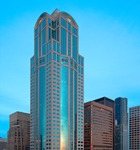
A. Exterior elevation of 1201 Third Avenue. Photo: Doug J Scott.
Upon its completion in 1988, Seattle’s 1201 Third Avenue building was cited by The New York Times as one of the three best new office buildings in the country, and Wright Runstad & Company, the property’s developer and manager, didn’t want to give up that recognition. Over the years, the firm maintained the building so well that eventually LEED certification seemed natural. “We were already so efficient, with an Energy Star score in the mid-90s, that we decided it made sense to formalize what we’d been doing over the years,” says Jeff Myrter, Wright Runstad’s general manager and director of property management. To examine all the elements that helped 1201 Third Avenue achieve LEED-EB Platinum certification, gb&d decided to break down the building’s sustainable features.
A. Exterior elevation. The 55-story, 1.1-million-square-foot office building—which was designed in part by Kohn Pedersen Fox Associates and constructed by Howard S. Wright—comprises an entire city block in Seattle’s financial district. It offers unparalleled views of the Cascade and Olympic Mountains, Lake Union, and Mt. Rainier.

B. The fountains in the Second Avenue Plaza are fed via captured storm water. Photo: Doug J Scott.
B. Second Avenue Plaza. At the base of 1201 Third Avenue is a two-story public plaza showcasing a decorative fountain surrounded by eye-catching landscaping, comfortable outdoor furnishings, and artwork (including the sculptural work New Archetypes by artist Poirier, which was donated by Wright Runstad). Moreover, water for the landscaping and fountain is sourced from repurposed storm water. “Instead of pumping water back to the city, we collect it in large plastic tanks in the lower parking garage then pump it up to the plaza to feed our irrigation system and our decorative fountain,” Myrter says, noting that the reclamation system reduced summer water consumption in 2010 by more than 15 percent. Although the investment has a payback of approximately five years, Myrter says, “It’s been so successful, we’re currently expanding the system to use reclaimed water to feed the cooling towers in the building.”

C. Entertainment options near 1201 Third Ave. include Brooklyn restaurant. Photo: Doug J Scott.
C. Entertainment. The Second Avenue Plaza is adjoined by the Brooklyn restaurant and the Friesen Gallery art space, and it hosts a number of events, including summer lunchtime concerts.

D. The Grand Atrium is extensively daylit and features exotic and natural materials. Photo: Doug J Scott.
D. Grand Atrium. Guiding visitors from the upper level of the Second Avenue Plaza is a symmetrical grand staircase leading to an atrium, which offers spectacular views through its 30-foot windows. Visitors and tenants can mingle in a lush setting—which includes Italian marble floors and warm African and Honduran mahogany walls—while enjoying espresso from a local stand and complimentary wireless Internet access.

E. Native landscaping reduces water use. Photo: Doug J Scott.
E. Native landscaping. As part of the LEED certification process, Wright Runstad replanted the flower beds of the lower plaza with flora native to the Pacific Northwest. The firm also implemented a satellite irrigation system, which waters plants more fastidiously in accordance with current weather conditions.

F. The preserved façade helps maintain Seattle's architectural legacy. Photo: Doug J Scott.
F. Preserved façade. At the northwest corner of the Second Avenue Plaza stands the preserved north and west facades of a 19th-century commercial building—one of the few such buildings remaining in the city.

G. Included were modern updates such as energy-efficient lighting. Photo: Doug J Scott.
G. Modern efficiencies. High-speed elevators ensure swift arrivals at tenant suites—which offer flexible environmental controls—thanks to a floor-by-floor mechanical system with an average of 35 separate zones per floor. Wright Runstad has also replaced bulbs in the lamps throughout the exterior walkways with energy-efficient options.

H. The parking garage includes bike storage and charging stations for electric cars. Photo: Doug J Scott.
H. Parking garage. A six-level, below-grade parking garage provides 801 spaces, all with easy access to Interstate 5 and Highway 99. Alternative commuting options are also available, including a direct connection to the Downtown Seattle Transit Tunnel, three Zipcars, and bike storage. Recently, Wright Runstad worked with transportation company ECOtality to even add four charging stations in the garage for electric cars.

